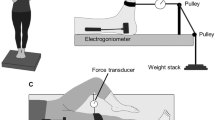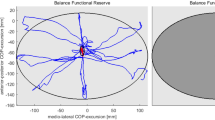Abstract
Background and aims
Age-related reductions in strength and power are considered to negatively impact balance control, but the existence of a direct association is still an issue of debate. This is possibly due to the fact that balance assessment is complex, reflects different underlying physiologic mechanisms and involves quantitative measurements of postural sway or timing of performance during balance tasks. The present study evaluated the moderator effect of static postural control on the association of power and strength with dynamic balance tasks.
Methods
Fifty-seven healthy 65–75 year old individuals performed tests of dynamic functional balance (walking speed under different conditions) and of strength, power and static postural control.
Results and conclusions
Dynamic balance performance (walking speed) was associated with lower limb strength and power, as well as postural control under conditions requiring postural adjustments (narrow surface walking r 2 = 0.31, p < 0.001). An interaction effect between strength and static postural control was found with narrow surface walking and talking while walking (change of β 0.980, p < 0.001 in strength for 1 SD improvements in static postural control for narrow walking, and \( \beta \) −0.730, p < 0.01 in talking while walking). These results indicate that good static postural control facilitates the utilisation of lower limb strength to better perform complex, dynamic functional balance tasks. Practical implications for assessment and training are discussed.

Similar content being viewed by others
References
Winter DA (1995) ABC: Anatomy, biomechanics and control of balance during standing and walking. Waterloo Biomechanics, Waterloo
Goble DJ, Coxon JP, Wenderoth N, Van Impe A, Swinnen SP (2009) Proprioceptive sensibility in the elderly: degeneration, functional consequences and plastic-adaptive processes. Neurosci Biobehav Rev 33:271–278
Horak FB (1997) Clinical assessment of balance disorders. Gait Posture 6:76–84
Howe TE, Rochester L, Neil F, Skelton DA, Ballinger C (2011) Exercise for improving balance in older people. Cochrane database of systematic reviews issue 11. doi:10.1002/14651858
Bassey EJ, Fiatarone MA, O’Neill EF, Kelly M, Evans WJ, Lipsitz LA (1992) Leg extensor power and functional performance in very old men and women. Clin Sci 82:321–327
Wolfson L, Judge J, Whipple R, King M (1995) Strength is a major factor in balance, gait, and the occurrence of falls. J Gerontol Biomed Sci Med Sci 50A (special issue):64–67
Bean JF, Leveille SG, Kiely DK, Bandinelli S, Guralnik JM, Ferrucci L (2003) A comparison of leg power and leg strength within the InCHIANTI study: which influences mobility more? J Gerontol 58A:728–733
Wiacek M, Hagner W, Hagner-Derengowska M, Bluj B, Drozd M, Czereba J, Zubrzycki IZ (2009) Correlations between postural stability and strength of lower body extremities of women population living in long-term care facilities. Arch Gerontol Geriatr 48:346–349
Stevens PJ, Syddall HE, Patel HP, Martin HJ, Cooper C, Sayer A (2012) Is grip strength a good marker of physical performance among community-dwelling older people? J Nutr Health Aging 16:769–774
Orr R, Raymond J, Fiatarone Singh M (2008) Efficacy of progressive resistance training on balance performance in older adults. a systematic review of randomized controlled trials. Sports Med 38:317–343
Granacher U, Muehlbauer T, Gruber M (2012) A qualitative review of balance and strength performance in healthy older adults: impact for testing and training. J Aging Res 708905. doi:10.1155/2012/708905
Muehlbauer T, Besemer C, Wehrle A, Gollhofer A, Granacher U (2012) Relationship between strength, power and balance performance in seniors. Gerontol 58:504–512
Skelton DA, Greig CA, Davies JM, Young A (1994) Strength, power and related functional ability of healthy people aged 65–89 years. Age Ageing 23:371–377
Ferrucci L, Guralnik JM, Buchner D, Kasper J, Lamb SE, Simonsick EM, Corti MC, Bandeen-Roche K, Fried LP (1997) Departures from linearity in the relationship between measures of muscular strength and physical performance of the lower extremities: the Women’s Health and Aging Study. J Gerontol 52A:M275–M285
Granacher U, Bridenbaugh SA, Muehlbauer T, Wehrle A, Kressig RW (2011) Age-related effects on postural control under multi-task conditions. Gerontol 57:247–255
Baron RM, Kenny DA (1986) The moderator-mediator variable distinction in social psychological research: conceptual, strategic, and statistical considerations. J Pers Soc Psychol 51:1173–1182
Aiken LS, West SG (1991) Multiple regression: testing and interpreting interactions. Sage, Newbury Park, CA
Greig CA, Young A, Skelton DA, Pippet E, Butler FM, Mahmud SM (1994) Exercise studies with elderly volunteers. Age Ageing 23:185–189
Ditroilo M, Forte R, Mckeown D, Boreham CAG, De Vito G (2011) Intra- and inter-session reliability of vertical jump performance in healthy middle-aged and older men and women. J Sports Sci 29:1675–1682
Moghadam M, Ashayeri H, Salavati M, Sarafzadeh J, Taghipoor KD, Saeedi A, Salehi R (2011) Reliability of center of pressure measures of postural stability in healthy older adults: effects of postural task difficulty and cognitive load. Gait Posture 33:651–655
Shumway-Cook A, Guralnik JM, Phillips CL, Coppin AK, Ciol MA, Bandinelli S, Ferrucci L (2007) Age-associated declines in complex walking task performance: the Walking InCHIANTI toolkit. J Am Geriatr Soc 55:58–65
Forte R, Boreham CA, Leite JC, De Vito G, Brennan L, Gibney ER, Pesce C (2013) Enhancing cognitive functioning in the elderly: multicomponent vs resistance training. Clin Interv Aging 8:19–27
Prieto TE, Myklebust JB, Hoffmann RG, Lovett EG, Myklebust BM (1996) Measures of postural steadiness: differences between healthy young and elderly adults. IEEE Trans Biomed Eng 43:956–966
World Health Organization (2001) International classification of functioning, disability and health: ICF. WHO, Geneva
Orr R (2010) Contribution of muscle weakness to postural instability in the elderly. A systematic review. Eur J Phys Rehabil Med 46:183–220
Ringsberg K, Gerdhem P, Johansson J, Obrant KJ (1999) Is there a relationship between balance, gait performance and muscular strength in 75-year-old women? Age Ageing 28:289–293
Patla AE, Winter DA, Frank JS, Walt SE, Prasad S (1990) Identification of age-related changes in the balance-control system. In: Duncan PW (ed) Balance. American Physical Therapy Association, Alexandria, pp 43–56
Era P, Sainio P, Koskinen S, Haavisto P, Vaara M, Aromaa A (2006) Postural balance in a random sample of 7,979 subjects aged 30 years and over. Gerontol 52:204–213
Bean JF, Kiely DK, Herman S, Leveille SG, Mizer K, Frontera WR, Fielding RA (2002) The relationship between leg power and physical performance in mobility-limited older people. J Am Geriatr Soc 50:461–467
Lord SR, Murray SM, Chapman K, Munro B, Tiedemann A (2002) Sit-to-stand performance depends on sensation, speed, balance, and psychological status in addition to strength in older people. J Gerontol 57A:M539–M543
Spink MJ, Fotoohabadi MR, Wee E, Hill KD, Lord SR, Menz HB (2011) Foot and ankle strength, range of motion, posture, and deformity are associated with balance and functional ability in older adults. Arch Phys Med Rehab 92:68–75
Hurley M, Rees J, Newham D (1988) Quadriceps function, proprioceptive acuity and functional performance in healthy young, middle-aged and elderly subjects. Age Ageing 27:55–62
Ketcham CJ, Seidler RD, Van Gemmert AWA, Stelmach GE (2002) Age-related kinematic differences as influenced by task difficulty, target size, and movement amplitude. J Gerontol Psychol Sci 57B:554–564
Yogev-Seligmann G, Hausdorff JM, Giladi N (2008) The role of executive function and attention in gait. Mov Disord 23:329–342
Forte R, Pesce C, Leite JC, De Vito G, Gibney ER, Tomporowski PD, Boreham CA (2013) Executive function moderates the role of muscular fitness in determining functional mobility in older adults. Aging Clin Exp Res 25:291–298
Montero-Odasso M, Verghese J, Beauchet O, Hausdorff JM (2012) Gait and cognition: a complementary approach to understanding brain function and the risk of falling. J Am Geriatr Soc 60:2127–2136
Frontera WR, Hughes VA, Lutz KJ, Evens WJ (1994) A cross-sectional study of muscle strength and mass in 45 to 78 yr-old men and women. J Appl Physiol 71:644–650
Acknowledgments
This research was carried out with the support of IRCSET “Irish Research Council for Science, Engineering and Technology”.
The authors wish to thank Sheena Murphy and Josianne Rodriguez Krause for their help during testing sessions.
On behalf of all authors the corresponding author declares the absence of any financial relationship with the organization that sponsored the research. She also declares the authors have full control of all primary data and allow the journal to review our data if requested.
Conflict of interest
None.
Author information
Authors and Affiliations
Corresponding author
Rights and permissions
About this article
Cite this article
Forte, R., Boreham, C.A.G., De Vito, G. et al. Measures of static postural control moderate the association of strength and power with functional dynamic balance. Aging Clin Exp Res 26, 645–653 (2014). https://doi.org/10.1007/s40520-014-0216-0
Received:
Accepted:
Published:
Issue Date:
DOI: https://doi.org/10.1007/s40520-014-0216-0




